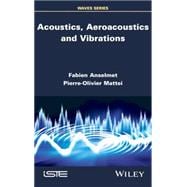This didactic book presents the main elements of acoustics, aeroacoustics and vibrations.
Illustrated with numerous concrete examples linked to solid and fluid continua, Acoustics, Aeroacoustics and Vibrations proposes a selection of applications encountered in the three fields, whether in room acoustics, transport, energy production systems or environmental problems. Theoretical approaches enable us to analyze the different processes in play. Typical results, mostly from numerical simulations, are used to illustrate the main phenomena (fluid acoustics, radiation, diffraction, vibroacoustics, etc.).








